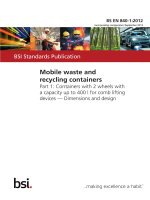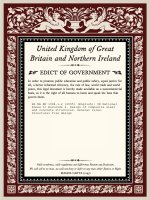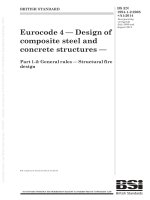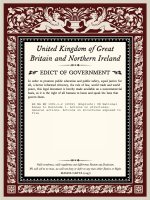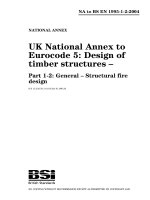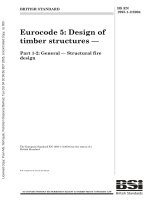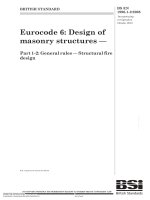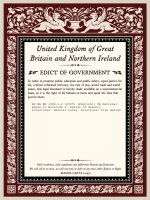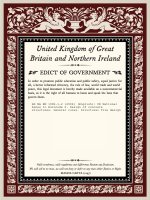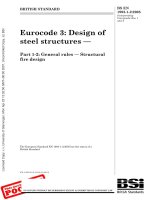Bsi bs en 61190 1 2 2014
Bạn đang xem bản rút gọn của tài liệu. Xem và tải ngay bản đầy đủ của tài liệu tại đây (1.41 MB, 26 trang )
BS EN 61190-1-2:2014
BSI Standards Publication
Attachment materials for
electronic assembly
Part 1-2: Requirements for soldering
pastes for high-quality interconnects
in electronics assembly
BRITISH STANDARD
BS EN 61190-1-2:2014
National foreword
This British Standard is the UK implementation of EN 61190-1-2:2014. It
is identical to IEC 61190-1-2:2014. It supersedes BS EN 61190-1-2:2007
which is withdrawn.
The UK participation in its preparation was entrusted to Technical Committee EPL/501, Electronic assembly technology & Printed Electronics.
A list of organizations represented on this committee can be obtained on
request to its secretary.
This publication does not purport to include all the necessary provisions of
a contract. Users are responsible for its correct application.
© The British Standards Institution 2014.
Published by BSI Standards Limited 2014
ISBN 978 0 580 77840 7
ICS 31.190
Compliance with a British Standard cannot confer immunity from legal obligations.
This British Standard was published under the authority of the
Standards Policy and Strategy Committee on 30 June 2014.
Amendments/corrigenda issued since publication
Amd. No.
Date
Text affected
BS EN 61190-1-2:2014
EUROPEAN STANDARD
EN 61190-1-2
NORME EUROPÉENNE
EUROPÄISCHE NORM
May 2014
ICS 31.190
Supersedes EN 61190-1-2:2007
English Version
Attachment materials for electronic assembly - Part 1-2:
Requirements for soldering pastes for high-quality interconnects
in electronics assembly
(IEC 61190-1-2:2014)
Matériaux de fixation pour les assemblages électroniques Partie 1-2: Exigences relatives aux pâtes à braser pour les
interconnexions de haute qualité dans les assemblages de
composants électroniques
(CEI 61190-1-2:2014)
Verbindungsmaterialien für Baugruppen der Elektronik - Teil
1-2: Anforderungen an Lotpaste für hochwertige
Verbindungen in der Elektronikmontage
(IEC 61190-1-2:2014)
This European Standard was approved by CENELEC on 2014-03-26. CENELEC members are bound to comply with the CEN/CENELEC
Internal Regulations which stipulate the conditions for giving this European Standard the status of a national standard without any alteration.
Up-to-date lists and bibliographical references concerning such national standards may be obtained on application to the CEN-CENELEC
Management Centre or to any CENELEC member.
This European Standard exists in three official versions (English, French, German). A version in any other language made by translation
under the responsibility of a CENELEC member into its own language and notified to the CEN-CENELEC Management Centre has the
same status as the official versions.
CENELEC members are the national electrotechnical committees of Austria, Belgium, Bulgaria, Croatia, Cyprus, the Czech Republic,
Denmark, Estonia, Finland, Former Yugoslav Republic of Macedonia, France, Germany, Greece, Hungary, Iceland, Ireland, Italy, Latvia,
Lithuania, Luxembourg, Malta, the Netherlands, Norway, Poland, Portugal, Romania, Slovakia, Slovenia, Spain, Sweden, Switzerland,
Turkey and the United Kingdom.
European Committee for Electrotechnical Standardization
Comité Européen de Normalisation Electrotechnique
Europäisches Komitee für Elektrotechnische Normung
CEN-CENELEC Management Centre: Avenue Marnix 17, B-1000 Brussels
© 2014 CENELEC All rights of exploitation in any form and by any means reserved worldwide for CENELEC Members.
Ref. No. EN 61190-1-2:2014 E
BS EN 61190-1-2:2014
EN 61190-1-2:2014
-2-
Foreword
The text of document 91/1154A/FDIS, future edition 3 of IEC 61190-1-2, prepared by IEC/TC 91
"Electronics assembly technology " was submitted to the IEC-CENELEC parallel vote and approved by
CENELEC as EN 61190-1-2:2014.
The following dates are fixed:
•
latest date by which the document has
to be implemented at national level by
publication of an identical national
standard or by endorsement
(dop)
2014-12-26
•
latest date by which the national
standards conflicting with the
document have to be withdrawn
(dow)
2017-03-26
This document supersedes EN 61190-1-2:2007.
EN 61190-1-2:2014 includes the following significant technical changes with respect to EN 61190-12:2007:
a) modification of the solder powder size in Table 2;
b) addition of the information of “Reflow condition and profile” in Annex B;
c) addition of a new Annex C.
Attention is drawn to the possibility that some of the elements of this document may be the subject of
patent rights. CENELEC [and/or CEN] shall not be held responsible for identifying any or all such
patent rights.
Endorsement notice
The text of the International Standard IEC 61190-1-2:2014 was approved by CENELEC as a
European Standard without any modification.
In the official version, for Bibliography, the following notes have to be added for the standards
indicated:
IEC 61189-5:2006
NOTE
Harmonised as EN 61189-5:2006 (not modified).
IEC 61189-6:2006
NOTE
Harmonised as EN 61189-6:2006 (not modified).
BS EN 61190-1-2:2014
EN 61190-1-2:2014
-3-
Annex ZA
(normative)
Normative references to international publications
with their corresponding European publications
The following documents, in whole or in part, are normatively referenced in this document and are
indispensable for its application. For dated references, only the edition cited applies. For undated
references, the latest edition of the referenced document (including any amendments) applies.
NOTE When an international publication has been modified by common modifications, indicated by (mod), the relevant EN/HD
applies.
Publication
Year
Title
EN/HD
Year
IEC 60194
-
Printed board design, manufacture and
assembly - Terms and definitions
EN 60194
-
IEC 61189-5-3
-
Test methods for electrical materials,
interconnection structures and assemblies Part 5-3: Test methods for printed board
assemblies: Soldering paste
EN 61189-5-3
-
IEC 61190-1-1
-
Attachment materials for electronic
assemblies Part 1-1: Requirements for soldering fluxes
-
-
IEC 61190-1-3
-
Attachment materials for electronic assembly - EN 61190-1-3
Part 1-3: Requirements for electronic grade
solder alloys and fluxed and non-fluxed solid
solders for electronic soldering applications
-
ISO 9454-2
-
Soft soldering fluxes - Classification and
requirements Part 2: Performance requirements
-
EN ISO 9454-2
BS EN 61190-1-2:2014
–2–
61190-1-2 IEC:2014
CONTENTS
INTRODUCTION ..................................................................................................................... 6
1
Scope .............................................................................................................................. 7
2
Normative references ...................................................................................................... 7
3
Terms and definitions ...................................................................................................... 7
4
Standardized description for products .............................................................................. 8
5
Test methods ................................................................................................................... 8
6
Requirements .................................................................................................................. 9
6.1
6.2
6.3
6.4
7
General .............................................................................................................. 9
Conflict .............................................................................................................. 9
Alloy composition ............................................................................................... 9
Flux characterization and inspection .................................................................. 9
6.4.1
General ............................................................................................ 9
6.4.2
Shelf life ......................................................................................... 10
Solder powder particle size .............................................................................. 10
6.5
6.5.1
Powder size determination .............................................................. 10
6.5.2
Powder size .................................................................................... 10
6.5.3
Solder powder particle shape.......................................................... 11
Metal per cent .................................................................................................. 11
6.6
6.7
Viscosity .......................................................................................................... 11
6.7.1
General .......................................................................................... 11
6.7.2
Methods of determining viscosity .................................................... 11
Slump and smear test ...................................................................................... 12
6.8
6.8.1
General .......................................................................................... 12
6.8.2
Test with 0,2 mm thick stencil ......................................................... 12
6.8.3
Test with 0,1 mm thick stencil ......................................................... 12
Solder ball test ................................................................................................. 13
6.9
6.9.1
General .......................................................................................... 13
6.9.2
Type 1-4 powder ............................................................................. 13
6.9.3
Type 5-7 powder ............................................................................. 13
Tack test .......................................................................................................... 14
6.10
6.11
Wetting ............................................................................................................ 14
6.12
Labelling .......................................................................................................... 14
Quality assurance provisions ......................................................................................... 15
7.1
7.2
7.3
7.4
7.5
Responsibility for inspection ............................................................................ 15
7.1.1
General .......................................................................................... 15
7.1.2
Responsibility for compliance ......................................................... 16
7.1.3
Test equipment and inspection facilities .......................................... 16
7.1.4
Inspection conditions ...................................................................... 16
Classification for inspections ............................................................................ 16
Inspection report form ...................................................................................... 16
Qualification inspection .................................................................................... 16
7.4.1
General .......................................................................................... 16
7.4.2
Sample size .................................................................................... 17
7.4.3
Inspection routine ........................................................................... 17
Quality conformance ........................................................................................ 17
BS EN 61190-1-2:2014
61190-1-2 IEC:2014
–3–
8
7.5.1
General .......................................................................................... 17
7.5.2
Sampling plan ................................................................................. 17
7.5.3
Rejected lots .................................................................................. 17
Preparation for delivery ................................................................................................. 17
9
Additional information – Performance and shelf life extension inspections ..................... 18
Annex A (normative) Test report on solder paste ................................................................. 19
Annex B (informative) Reflow condition and profile .............................................................. 20
Annex C (informative) Typical comparison of particle size distributions between laser
diffraction method and screen method ........................................................................... 21
Bibliography .......................................................................................................................... 22
Figure 1 – Slump test stencil thickness, 0,20 mm .................................................................. 12
Figure 2 – Slump test stencil thickness, 0,10 mm .................................................................. 13
Figure 3 – Solder ball test standards ..................................................................................... 15
Figure C.1 – Typical comparison between laser diffraction and sieving ................................. 21
Table 1 – Standardized solder paste description ..................................................................... 8
Table 2 – Standard solder powders ....................................................................................... 10
Table 3 – Test methods for particle size distribution ............................................................. 11
Table 4 – Solder paste qualification inspection ..................................................................... 17
Table 5 – User inspection for solder paste prior to use ......................................................... 18
Table A.1 – Solder paste inspection report form .................................................................... 19
BS EN 61190-1-2:2014
–6–
61190-1-2 IEC:2014
INTRODUCTION
This part of IEC 61190 defines the characteristics of solder paste through the definitions of
properties and specification of test methods and inspection criteria. Materials include solder
powder and solder paste flux blended to produce solder paste. Solder powders are classified
according to both shape and size distribution of the particles. It is not the intention of this
standard to exclude those particle sizes or distributions not specifically listed. For flux
properties of solder paste, including classification and testing, see IEC 61190-1-1.
The requirements for solder paste are defined in general terms. In practice, where more
stringent requirements are necessary, additional requirements may be defined by mutual
agreement between the user and supplier. Users are cautioned to perform tests (beyond the
scope of this specification) to determine the acceptability of the solder paste for specific
processes.
This standard is intended to be applicable to all types of solder paste used for soldering in
general, as well as for soldering in electronics assembly. The solder pastes involved relate to
all aspects of application. Generic specifications for soldering pastes are given in ISO 9454-2.
BS EN 61190-1-2:2014
61190-1-2 IEC:2014
–7–
ATTACHMENT MATERIALS FOR ELECTRONIC ASSEMBLY –
Part 1-2: Requirements for soldering pastes
for high-quality interconnects in electronics assembly
1
Scope
This part of IEC 61190 specifies general requirements for the characterization and testing of
solder pastes used to make high-quality electronic interconnections in electronics assembly.
This standard serves as a quality control document and is not intended to relate directly to the
material's performance in the manufacturing process.
Related information on flux characterization, quality control and procurement documentation
for solder flux and flux containing material may be found in IEC 61190-1-1.
2
Normative references
The following documents, in whole or in part, are normatively referenced in this document and
are indispensable for its application. For dated references, only the edition cited applies. For
undated references, the latest edition of the referenced document (including any
amendments) applies.
IEC 60194, Printed board design, manufacture and assembly – Terms and definitions
IEC 61189-5-3 1 , Test methods for electrical materials, interconnection structures and
assemblies – Part 5-3: Test methods for printed board assemblies: Soldering paste
IEC 61190-1-1, Attachment materials for electronic assembly – Part 1-1: Requirements for
soldering fluxes for high quality interconnections in electronics assembly
IEC 61190-1-3, Attachment materials for electronic assembly – Part 1-3: Requirements for
electronic grade solder alloys and fluxed and non-fluxed solid solders for electronic soldering
applications
ISO 9454-2, Soft soldering fluxes – classification and requirements – Part 2: Performance
requirements
3
Terms and definitions
For the purposes of this document, the terms and definitions given in IEC 60194, as well as
the following apply.
3.1
drying
ambient or heating process to evaporate volatile components from solder paste which may, or
may not, result in melting of rosin/resin
3.2
rheology
___________
1 To be published.
BS EN 61190-1-2:2014
–8–
61190-1-2 IEC:2014
study of the change in form and the flow of matter, generally characterized by elasticity,
viscosity, and plasticity
3.3
lead free solder
solder alloy which lead content is equal to, or less than 0,10 % by mass
3.4
thinner
thinner paste
solvent or paste system with, or without, activator which is added to solder paste to replace
evaporated solvents, adjust viscosity, or reduce solids content
3.5
viscosity
internal friction of a fluid, caused by molecular attraction, which makes it resist a tendency to
flow, expressed in pascal-seconds (Pa·s)
4
Standardized description for products
The solder paste product shall be described as outlined in Table 1.
Table 1 – Standardized solder paste description
Alloy
designation
Flux
classification a
Designation from
IEC 61190-1-3
Classification from
IEC 61190-1-1
or ISO 9454-2
Powder size
type
Type no. b
Nominal metal
content
Viscosity
Weight per cent
Pa·s
a
As defined and determined in IEC 61190-1-1 for low (L), moderate (M), and high (H) activity of the flux residues.
b
See Table 2.
5
Test methods
The test methods used in this standard are taken from IEC 61189-5-3:
Test methods for electrical materials, interconnection structures
Part 5-3:Test methods for printed board assemblies: Soldering paste:
and
assemblies
–
5-3X01 Paste flux viscosity – T-Bar spindle method (5X02) 2
5-3X02 Spread test, liquid or extracted solder flux and solder paste (5X03) 2
5-3X03 Solder paste viscosity – t-bar spin spindle method (applicable for 300 Pa-s to
1 600 Pa-s) (5X04) 2
5-3X04 Solder paste viscosity – t-bar spindle method (applicable at less than 300 Pa-s)
(5X05) 2
5-3X05 Solder paste viscosity – spiral pump method (for 300 Pa-s to 1 600 Pa-s) (5X06) 2
5-3X06 Solder paste viscosity – spiral pump method (applicable at less than 300 Pa-s)
(5X07) 2
5-3X07 Solder paste – slump test (5X08) 2
___________
2
(5X0x ) ; Test number in IEC 61189-5:2006, see Bibliography.
BS EN 61190-1-2:2014
61190-1-2 IEC:2014
–9–
5-3X08 Solder paste – solder ball test (5X09) 2
5-3X09 Solder paste – tack test (5X10) 2
5-3X10 Solder paste – wetting test (5X11) 2
5-3X11 Solder powder particle size distribution – screen method (6X01) 3
5-3X12 Solder powder particle size distribution – measuring microscope method (6X02) 3
5-3X13 Solder powder particle size distribution – optical image analyzer method (6X03) 3
5-3X14 Solder powder particle size distribution – Measuring laser diffraction method (6X04) 3
5-3X15 Determination of maximum solder powder particle size ( 6X05) 3
5-3X16 Solder paste metal content by weight (6X06) 2
6
Requirements
6.1
General
Except when otherwise specified in the design or assembly drawings, or instructions by the
user, the soldering pastes covered by this standard shall conform with 6.2 to 6.12.
6.2
Conflict
In the event of conflict between the requirements of this standard and other requirements of
the applicable acquisition documents, the precedence in which documents shall govern in
descending order is as follows:
a) the applicable acquisition document;
b) the applicable specification sheet/drawing;
c) this standard;
d) applicable normative references.
6.3
Alloy composition
The alloy composition of the solder pastes shall be characterized by the supplier in
accordance with the alloy characterization requirements specified in IEC 61190-1-3 and shall
be inspected in accordance with the alloy inspection requirements of IEC 61190-1-3. The
results of these inspections should be recorded on the report form included in IEC 61190-1-3
and the alloy type shall be recorded on the solder paste report form (see Table A.1).
The percentage of each element in an alloy shall be determined by any standard analytical
procedure. Wet chemistry shall be used as the reference procedure.
6.4
6.4.1
Flux characterization and inspection
General
The fluxes in solder pastes shall be characterized by the supplier in accordance with the flux
characterization requirements specified in IEC 61190-1-1 and shall be inspected in
accordance with the flux inspection requirements of IEC 61190-1-1. The results of these
inspections should be recorded on the report form included in IEC 61190-1-1 and the flux type
shall be recorded on the solder paste report form (see Table A.1). If the reflow temperature is
unsuitable for inspection, a different reflow temperature should be agreed upon by user and
supplier.
___________
3
(6X0x ) ; Test number in IEC 61189-6:2006, see Bibliography.
BS EN 61190-1-2:2014
– 10 –
6.4.2
61190-1-2 IEC:2014
Shelf life
If the shelf life of the solder paste has expired, but the paste still meets performance testing,
then it may be used. Paste which has been re-qualified can only be used directly after requalification.
6.5
Solder powder particle size
6.5.1
Powder size determination
Powder size determination shall be made using this standard. Alternate test procedures may
be agreed upon by user and supplier.
6.5.2
Powder size
6.5.2.1
General
When tested in accordance with 6.5.2.2, the powder size shall be classified by type as per a
standard sieve size or the nearest sieve size shown which matches the values of Table 2.
Table 2 – Standard solder powders
a
Type a
Less than 0,5 %
larger than
µm
10 % Maximum
between
µm
80 % Minimum
between
µm
10 % Maximum
less Than
µm
1
160
150 to 160
75 to 150
75
2
80
75 to 80
45 to 75
45
3
60
45 to 60
25 to 45
25
4
50
38 to 50
20 to 38
20
5
40
25 to 40
15 to 25
15
6
25
15 to 25
5 to 15
5
7
15
11 to 15
2 to 11
2
Basic powder size symbol for each powder size type.
6.5.2.2
Maximum powder size (fineness of grind)
The maximum powder size shall be determined in accordance with IEC 61189-5-3, Test
method 5-3X15 (6X05) 2 .
6.5.2.3
Solder powder
Powder particle size distribution shall be determined by a suitable test method using
IEC 61189-5-3, Test methods 5-3X11 (6X01) 2 , 5-3X12 (6X02) 2 , 5-3X13 (6X03) 2 or 53X14(6X04) 2 for minimum particle size, as shown in Table 3.
BS EN 61190-1-2:2014
61190-1-2 IEC:2014
– 11 –
Table 3 – Test methods for particle size distribution
6.5.3
Type of weight per cent
nominal size
Test methods
1, 2
1, 2, 3, 4
3, 4
2, 3, 4
5, 6, 7
3, 4
1
Sieve method
2
Microscopic method
3
Optical image analyzer
4
Laser scattering reflectometry 4
Solder powder particle shape
6.5.3.1
Powder shape
Solder powder shape shall be spherical with maximum length-to-width ratio of 1,2 when tested
in accordance with 6.5.3.2. Other shapes shall be acceptable if agreed upon by user and
supplier.
6.5.3.2
Determination of solder powder particle shape
Solder powder particle shape shall be determined by visual observation of the powder with a
binocular microscope at a magnification sufficient to determine the percentage that are
spherical or elliptical (length-to-width ratio of less than 2). Alternatively determine the
percentage of particles with aspect ratio of 1,2 or less using image analysis. Powder with 90 %
of the particles that are spherical shall be classified as spherical; all other powders shall be
classified as non-spherical.
Solder powder roundness is determined with a light beam scatter and shall be classified as
spherical if the deviation is 1:0 (perfectly spherical) to 1:07. Powders with values above 1:07
shall be classified as non-spherical.
6.6
Metal per cent
The metal content should be range from 65 % (by weight) to 96 % (by weight) when tested in
accordance with IEC 61189-5-3, test method 5-3X16(6X06) 2 . The metal per cent shall be
within ± 1 % of the nominal value specified on the user's purchase order.
6.7
6.7.1
Viscosity
General
If a measure of viscosity is required it shall be as agreed between user and supplier. The
measurement and test conditions shall be in accordance with 6.7.2.
6.7.2
Methods of determining viscosity
The methods for determining the viscosity of solder paste in the range of 300 Pa·s
1 600 Pa·s shall be in accordance with IEC-61189-5-3, test method 5-3X03, or test method
3X05. The method for determining viscosity of solder paste in the range of 50 Pa·s
300 Pa·s shall be in accordance with IEC 61189-5-3, test method 5-3X04 or test method
3X06.
to
5to
5-
___________
4
See Annex C (informative): Typical comparison of particle size distributions between laser diffraction method
and screen method.
BS EN 61190-1-2:2014
– 12 –
6.8
6.8.1
61190-1-2 IEC:2014
Slump and smear test
General
Unless otherwise specified in the contract or purchase order, slump is assessed using two
stencil thicknesses and three land (deposit) sizes in accordance with 6.7.2 and 6.8.3.
6.8.2
Test with 0,2 mm thick stencil
The 0,63 mm × 2,03 mm lands of the stencil shown in Figure 1 when tested in accordance
IEC-61189-5-3, test method 5-3X07 at ambient, should show no evidence of bridging between
lands when spacing is 0,56 mm or greater. When tested in accordance with IEC-61189-5-3,
test method 5-3X07 at elevated temperature, the specimen shall show no evidence of bridging
between pads when the spacing is 0,63 mm or greater. The 0,33 mm × 2,03 mm lands of the
stencil shown in the Figure 1 pattern, when tested in IEC-61189-5-3, test method 5-3X07 at
ambient, shall show no evidence of bridging at spacing of 0,25 mm or greater; and when
tested as per IEC-61189-5-3, test method 5-3X07 at elevated temperature, they shall show no
evidence of bridging at spacing of 0,30 mm or greater.
Spacing
mm
Spacing
mm
0,33
0,41
0,48
0,56
0,63
0,06
0,71
0,79
0,71
0,63
0,56
0,48
0,41
0,33
Spacing
mm
Pad size: 0,63 mm × 2,03 mm
– 14 identical pads per row
– Same spacings each row
0,10
0,15
0,20
0,25
0,30
0,35
Vertical
row
0,40
0,45
0,40
0,35
0,30
0,25
0,20
Spacing
mm
0,15
0,10
0,06
Pad size: 0,33 mm × 2,03 mm
– 18 identical pads per row
– Same spacings each row
IEC 0613/14
Figure 1 – Slump test stencil thickness, 0,20 mm
6.8.3
Test with 0,1 mm thick stencil
The 0,33 mm × 2,03 mm lands of the stencil shown in Figure 2, when tested in accordance
IEC-61189-5-3, test method 5-3X07 at ambient, should show no evidence of bridging at
spacing of 0,25 mm or greater. When tested as per IEC-61189-5-3, test method 5-3X07 at
elevated temperature, the lands shall show no evidence of bridging at spacing of 0,30 mm or
greater.
BS EN 61190-1-2:2014
61190-1-2 IEC:2014
– 13 –
The 0,2 mm × 2,03 mm lands of the stencil shown in Figure 2, when tested in accordance with
IEC-61189-5-3, test method 5-3X07 at ambient, shall show no bridging at spacing of
0,175 mm or greater. When tested in accordance with IEC-61189-5-3, test method 5-3X07 at
elevated temperature, the lands shall show no evidence of bridging at spacing of 0,20 mm or
greater.
Pad size: 0,20 mm × 2,03 mm
– 16 identical pads per row
– Same spacings each row
Spacing
mm
0,06
0,10
0,15
0,20
0,25
0,30
0,35
0,40
0,45
0,40
0,35
0,30
Spacing
mm
Vertical
row
0,075
0,100
0,125
0,150
0,175
0,200
0,250
0,300
0,25
0,250
0,20
0,200
0,175
0,150
0,125
0,100
0,075
0,15
0,10
0,06
Spacing
mm
Spacing
mm
Pad size: 0,33 mm × 2,03 mm
– 18 identical pads per row
– Same spacings each row
IEC 0614/14
Figure 2 – Slump test stencil thickness, 0,10 mm
6.9
6.9.1
Solder ball test
General
The solder paste, when tested in accordance with the applicable method listed below, shall
meet the requirements for random solder particles (solder balls) as specified. If the solder
paste is required to reflow in a nitrogen atmosphere, for example in the case of indium (In)
containing solder paste, a solder ball test under controlled nitrogen atmosphere should be
allowable.
6.9.2
Type 1-4 powder
The solder paste with type 1 through 4 type powder, as defined in IEC-61189-5-3, test method
5-3X08, shall meet the acceptance criteria presented in Figure 3. In addition, individual solder
balls of greater than 75 µm shall not form on more than one of the three test patterns used in
the evaluation.
6.9.3
Type 5-7 powder
The solder paste with type 5 through 7 type powder as defined in IEC-61189-5-3, test method
5-3X08, shall meet the acceptance criteria presented in Figure 3. If necessary, it is
recommended to test in a controlled nitrogen atmosphere. In addition, individual solder balls
of greater than 50 µm shall not form on more than one of the three test patterns used in the
evaluation. Tests shall be performed while specimen is in a controlled nitrogen atmosphere.
BS EN 61190-1-2:2014
– 14 –
6.10
61190-1-2 IEC:2014
Tack test
The solder paste shall be tested in accordance with IEC-61189-5-3, test method 5-3X09.
Minimum holding force and time shall be agreed upon by user and supplier.
6.11
Wetting
When tested in accordance with IEC-61189-5-3, test method 5-3X10, the solder paste shall
uniformly wet the copper lands of the coupon without evidence of dewetting or non-wetting. If
the solder paste is required to reflow under a nitrogen atmosphere, for example in case of
indium (In) containing solder paste, wetting test under a controlled nitrogen atmosphere
should be allowable.
6.12
Labelling
The supplier shall label each container of solder paste with the following:
a) the supplier's name and address;
b) the paste classification/designation, for example, designation of alloy name, designation of
powder size , flux classification, and supplier's designation of the solder paste, if different;
c) the net mass of solder paste;
d) the batch number;
e) the date of manufacture;
f)
expiration date (see Clause 9);
g) all required environment, health and safety warnings;
h) percent metal;
i)
information about lead free soldering process if necessary.
BS EN 61190-1-2:2014
61190-1-2 IEC:2014
– 15 –
IEC
0615/14
IEC
0616/14
The solder paste has melted into a big single solder
ball.
The solder paste has melted into a big solder ball,
which must not be surrounded by clustered small
solder balls.
a) Category 1 – Preferred (pass)
b) Category 2 – Acceptable (pass)
IEC
0617/14
IEC
0618/14
The solder paste has melted into a big solder ball,
which is surrounded by clustered solder balls.
The molten solder paste has not melted completely or
has formed many individual solder balls.
c) Category 3 – Unacceptable, clusters
(reject)
d) Category 4 – Unacceptable (reject)
Figure 3 – Solder ball test standards
7
Quality assurance provisions
7.1
7.1.1
Responsibility for inspection
General
The solder paste supplier is responsible for the performance of all inspection specified herein
except the performance inspections which are the responsibility of the user. The solder paste
BS EN 61190-1-2:2014
– 16 –
61190-1-2 IEC:2014
supplier may use its own or any other facilities suitable for the performance of the inspections
specified herein, unless disapproved by the user. The user reserves the right to perform any
of the inspections set forth in the specification where such inspections are deemed necessary
to ensure that supplies and services conform to prescribed requirements.
7.1.2
Responsibility for compliance
7.1.2.1
General
Materials covered by this specification shall meet all requirements of Clause 6. The
inspection(s) excluding the performance inspections defined in this specification shall become
a part of the supplier's overall inspection system or quality program. The supplier has
responsibility of ensuring that all products or supplies submitted to the user for acceptance
comply with all requirements of the purchase order contract.
7.1.2.2
Quality assurance program
When required by the user, a quality assurance program for material furnished under this
specification shall be established and maintained in accordance with a quality assurance
system, or as otherwise agreed on between user and supplier, and shall be monitored by the
qualifying activity.
7.1.3
Test equipment and inspection facilities
Test/measuring equipment and inspection facilities, of sufficient accuracy, quality, and
quantity to permit performance of the required inspection(s), shall be established and
maintained or designated by the supplier. Establishment and maintenance of a calibration
system to control the accuracy of the measuring and test equipment shall be in accordance
with an agreed-upon quality assurance system.
7.1.4
Inspection conditions
Unless otherwise specified herein, all inspections shall be performed in accordance with the
test conditions specified in Clause 6.
7.2
Classification for inspections
The inspections specified herein are classified as follows:
a) qualification inspection (7.4);
b) quality conformance (7.5);
c) performance inspection (9).
7.3
Inspection report form
Table A.1 is a report form suitable, and recommended, for recording the results of solder
paste inspections. Where definitive test results are not required or appropriate, successful
completion of inspections should be indicated by checkmarks on the solder paste report form.
7.4
7.4.1
Qualification inspection
General
Qualification inspection may be performed at accredited laboratory or a laboratory acceptable
to the user on samples produced with equipment and procedures normally used in production.
BS EN 61190-1-2:2014
61190-1-2 IEC:2014
7.4.2
– 17 –
Sample size
Sample sizes shall be appropriate to the solder paste being inspected and the inspection
being performed.
7.4.3
Inspection routine
The sample shall be subjected to the inspections specified in Table 4.
Table 4 – Solder paste qualification inspection
Inspection
Metal content (6.6)
IEC 61189-5-3 test method
5-3X16(6X05) 2
Qualification
X
Viscosity (6.7.2)
5-3X03, 5-3X04, 5-3X05, 5-3X06
X
Solder ball (6.9.2, 6.9.3)
5-3X08
X
Slump (6.8.2, 6.8.3)
5-3X07
X
Alloy composition (6.3)
Standard analytical procedure
X
Flux characterization (6.4)
IEC 61190-1-1
X
Flux characteristics (6.4)
IEC 61190-1-1
X
Powder size (6.5.2.3)
5-3X11(6X01) 2 , 5-3X12(6X02) 2 , 5-3X13(6X03) 2 ,
5-3X14(6X04) 2
X
Maximum powder size (6.5.2.2)
5-3X15(6X04) 2
X
Powder shape (6.5.3.2)
Binocular microscope, sufficient magnification
X
Tack (6.10)
5-3X09
X
Wetting (6.11)
5-3X10
X
7.5
Quality conformance
7.5.1
General
The material supplier shall perform those inspections necessary to insure that the process is
in control and to insure that the product is within specification limit.
7.5.2
Sampling plan
Statistical sampling and inspection shall be in accordance with an approved quality program.
(See 7.1.2).
7.5.3
Rejected lots
If an inspection lot is rejected, the supplier may modify it to correct the defects, or screen out
the defective units and resubmit for reinspection. Resubmitted lots shall be subject to
tightened inspection. Such lots shall be separate from new lots, and shall be clearly identified
as reinspected lots.
8
Preparation for delivery
Preservation packaging, packing and marking for shipment, and identification shall be as
specified in the contract or purchase order.
BS EN 61190-1-2:2014
– 18 –
9
61190-1-2 IEC:2014
Additional information – Performance and shelf life extension inspections
Performance inspections are useful in assessing how well the solder products will perform in
a particular application. Table 5 indicates the methodology that the user should employ to
verify performance and shelf life extension of solder paste.
Table 5 – User inspection for solder paste prior to use
Inspections
IEC 61189-5-3
test method
Visual
Viscosity (6.7.2)
5-3X03, 5-3X04,
Performance
Shelf life
extension
X
X
X
X
5-3X05, 5-3X06
Solder ball (6.9.2, 6.9.3)
5-3X08
X
Slump (6.8.2, 6.8.3)
5-3X07
X
Tack (6.10)
5-3X09
X
Wetting (6.11)
5-3X10
X
BS EN 61190-1-2:2014
61190-1-2 IEC:2014
– 19 –
Annex A
(normative)
Test report on solder paste
Table A.1 – Solder paste inspection report form
Enter appropriate/information in top portion of report and complete report by entering the test
results or checkmarks in the appropriate spaces. Add the measurements, values, pictures, et
al. as an attachment to this report.
Inspection purpose:
_____Qualification
Supplier’s identification________________
_____Shelf life extension
Supplier’s batch number________________
_____Performance
Date of manufacture ___________________
Original USE-by date___________________
Revised USE-by date___________________
Date inspection completed: ________________________
Overall results: ______Pass_____Fail
Inspection performed by:
Witnessed by:
________________________
Inspections
Requirement
clause
____________________________
Test method
User’s actual
requirement
Test
result
P/F *
Material
Visual
Metal content
Viscosity
Solder ball
Slump
Alloy
Flux
Powder size
% in top screen
% in bottom screen
% in receiver bottom
Max. powder size
Powder shape
Tack
Wetting
* P/F = pass/fail; enter P if test results are within tolerance of actual requirement; otherwise, enter F.
Tested by and date
BS EN 61190-1-2:2014
– 20 –
61190-1-2 IEC:2014
Annex B
(informative)
Reflow condition and profile 5
While a number of factors can cause formation of solder balls, solder beading and splatter
during the reflow process, the introduction of no-clean processes in electronic manufacturing
has given rise to greater levels of solder balling. Solder balling appears as one or more
spheres of solder separated from the main body of the solder connection with a typical
diameter of around 0.5 mm or less. The following process evaluations are recommended for
improving the process in order to avoid this condition.
Change profile: Change temperature profile to reduce solder balling and beading should be
done in accordance with paste manufacture’s recommended specification.
Change atmosphere: As solid-content, or activator levels, are reduced, it may become
necessary to recommend reflow in atmosphere containing less than the standard 21% oxygen
(air).
Preheat: Higher temperatures, and longer times at those temperatures, volatilize activators
o
o
rapidly. Most organic materials have a measurable vapor pressure over 150 C (302,0 F).
Also, the oxidation of metal surfaces (solder powder and land/component terminations, alike)
is increased by longer times at high temperatures. Lowering the preheat temperature and
shortening the preheat time allow more paste vehicles to remain liquid into reflow portion of
the profile. This tends to reduce the formation of solder balls.
Atmosphere type: Reduced oxygen environments (e.g. a nitrogen atmosphere) can potentially
reduce or eliminate certain soldering defects such as solder balling. Nitrogen improves
coalescence without increasing paste activation. Additionally, nitrogen offers an added benefit
by eliminating reoxidation after the initial surface activation has been completed.
Deposit size: Thicker and wider paste deposits lose activator more slowly than small, thin
ones, due to their lower surface area/volume ratio.
If necessary, reference can be made to Appendix A “Mass reflow assembly of 02/01
components”, Appendix B “Qualification of Solder beading and Tombstoning in passive
Devices using Designed Experiments” and Appendix C “A materials based solution for the
Elimination of Tombstones” of the “Guide of solder paste assessment, IPC-HDBK-005”.
___________
5
See IPC-HDBK-005, 8.2.6 Process strategies.
BS EN 61190-1-2:2014
61190-1-2 IEC:2014
– 21 –
Annex C
(informative)
Typical comparison of particle size distributions
between laser diffraction method and screen method 6
There is an incompatibility between methods such as sieving and image analysis that
measure powder size distributions directly, and methods such as laser sizing which measure
powder size distributions indirectly and use algorithms to derive powder size distributions
from measured data.
Laser sizing methods are attractive because they can analyze relatively large powder samples
and give very reproducible results, in contrast to image analysis which can only examine
small powder samples and give poorly reproducible results.
Laser sizing methods use algorithms to calculate particle size distributions from scattering
data. The algorithms assume smooth wide particle size distributions and do not give reliable
(true) powder size distributions when applied to powder size distributions with sharp (sieved)
cut-offs. In addition, different machines use different algorithms and give different results. The
following Figure C.1 discusses drawbacks of laser sizing.
In order to give a true oversize measurement it is recommended to calibrate sizing powder
size distributions against other direct sizing methods such as image analysis.
The following figure is a graph from Malvern Instruments 7 showing different oversize
measurements between sieving and laser sizing.
100
Cumulative volume (%)
Sieving
Laser diffraction
75
50
25
0
100
Size / Microns
1 000
Typical comparison between laser diffraction and sieving showing how the different
properties measured by each technique changes the reported size distribution.
IEC 0619/14
Figure C.1 – Typical comparison between laser diffraction and sieving
___________
6
Information from UK on particle size distributions measured by different properties.
7 Reproduced with the permission of Malvern Instruments Ltd.
BS EN 61190-1-2:2014
– 22 –
61190-1-2 IEC:2014
Bibliography
IEC 61189-5:2006, Test methods for electrical materials, interconnection structures and
assemblies - Part 5: Test methods for printed board assemblies
IEC 61189-6:2006, Test methods for electrical materials, interconnection structures and
assemblies - Part 6: Test methods for materials used in manufacturing electronic assemblies
IPC-HDBK-005, Guide of solder paste assessment
____________
This page deliberately left blank
